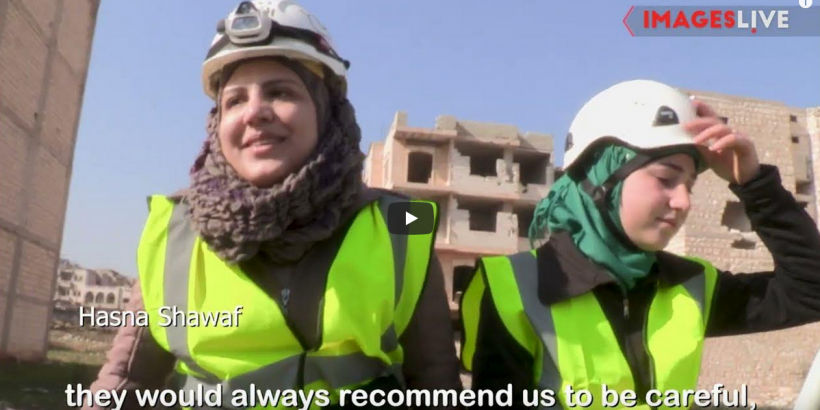Film by Osama Jumaa
As the war got underway in Syria following the Arab Spring uprising in the country, journalist Osama Jumaa documented the tragic reality on the ground and the brutality of the conflict, while also filming stories of resilience and hope amid the ongoing violence. As the fighting set in, a number of women took up arms and joined the battles, like the Umma Aisha Women’s Brigade who confront the Syrian government forces in the Aleppo Citadel, where ancient monuments are used as barricades. Also, in the old city of Aleppo former female detainee Marwa assists her husband in his effort to build an anti-aircraft rocket in their home. With the war in full blast, former teacher Hasna, law student Eba, and Maysa, become nurses and join the Civil Defence to rescue and assist people trapped under the rubble. Osama would film their work and highlight its enormous danger, especially when Eba is injured in airstrikes at the MSF-supported hospital in Maarat Al Numan. As a deep fuel crisis grips Syria and compounds the country’s misfortunes, the elderly woman Marsha finds herself among the many Syrians forced back to burning branches for cooking and heating. Despite the profound despair surrounding her in Saraqib, Safaa sings for the Syrian revolution while longing for peace, with her father accompanying her with the oud musical instrument. In Atma, Sana engages with a group of children of detainees, teaching them to dance, sing, and act. Sana would then tour Syrian IDP camps with her young team to offer respite to displaced children. Osama had resumed the filming Medyan had begun of documenting the stories of Syrian women who find themselves trapped in a violent and never-ending conflict, with Osama continuing their stories while the city of Aleppo was under intense bombardment. Osama had trained in Turkey and on the ground in Syria in journalism and photography as well as in the production of documentaries with IMAGESLIVE. Unlike many other young Syrians, Osama fully understood and embraced the basic principles of journalism. Moreover, Osama never joined any of the warring factions nor any party or organization during the Syrian conflict, thus always maintaining an objective approach to the conflict, which was reflected in his impartiality and high professionalism as a journalist. Tragically, on June 5, 2016, Osama lost his life after being injured by shrapnel from artillery shells fired by the Syrian government forces in Aleppo’s Al-Mashad district. Osama had gone to that neighbourhood to film rescue operations after an attack with barrel bombs. Thus, the filming terminates abruptly, with Osama’s tragic passing inflicting another major loss on war-scarred Syria. Osama left us, but the images he filmed remain vivid in the hearts, stirring strong emotions in people’s conscience, as he highlights the brutality of war, with its destruction, devastation, and immense suffering. Osama had interviewed the women working in the Civil Defence and had met Safa while she was chanting about the recent Russian bombing operations; and before he was killed, he had arranged to meet with the female fighters. Osama would film life-saving operations at the hands of the Civil Defence women in various towns. The story suddenly came to a halt because of Osama’s tragic passing; yet Syria’s map of territorial control had also shifted, and a number of female fighters were killed. Marsha sadly passed away and Sana moved after she got married. Marwa left Aleppo for the city of Al-Bab with her husband and children, and contact with the remaining characters of the story was lost
Director: Medyan Dairieh
Filming by: Osama Jumaa and Medyan Dairieh
Editors: Zakariya Yahya and Muhammad Ata
Production: IMAGESLIVE-Turkish Branch, where Osama worked

